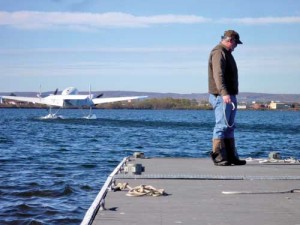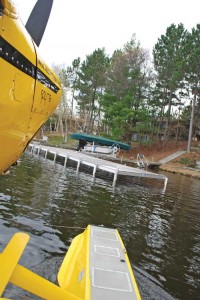by Rachel Obermoller
MNDOT Office of Aeronautics
In a seaplane pilot’s ideal world, every day would be 5 to 10 knot winds with light chop on the water, clear skies, and dead calm winds in a sheltered docking area. Unfortunately, this is rarely the case, which brings up one of my least favorite topics and what I refer to as the number one cause of non-fatal seaplane damage – docking. I lack the statistics to back this up, but in my experience, every seaplane that sees much time on the water has some evidence of contact with a dock. From minor scrapes and dents on the floats to dents in the wings, struts, and even propeller damage in the worst cases, docking has some distinct challenges and risks.
Even non-seaplane pilots who have driven a large boat or pontoon up to a dock or lift on a breezy day can appreciate the skill it takes to maneuver an airplane on floats up to a dock, especially a plane with no reverse and a dock with no room to go around. Beyond the lack of reverse, seaplane pilots must also account for the rest of the aircraft as well – the wings, struts, tail feathers, and engine and propeller. Each of these present unique challenges in different circumstances, and are all things a seaplane pilot must consider when docking in addition to the wind, type of dock, available help, ropes on the plane and on the dock, available space to maneuver, and a host of other considerations that vary from situation to situation, aircraft to aircraft, and pilot to pilot.
This time of year is typically the beginning of the seaplane season here in the northern climates, and it is also a good time to revisit basic skills, proficiency, and test the waters cautiously until our skills are up to par. A good seaplane pilot respects the wind as well as their own limitations and those of the airplane. Just because we could do something, doesn’t mean we should do something, and this applies as much to operating on big water or in a strong crosswind as it does to docking. While the potential for really serious damage may decrease at slow speeds and with the engine shut down, it never goes away. The best seaplane pilots are not the ones who make a perfectly smooth landing every time, but the ones who know how to maneuver their plane once they are on the water, understand their options, and know how to use these options to put the plane exactly where they want it to be.
These options include approaching under power, controlling your speed through power and wind management, and knowing when to sail the aircraft or let it drift into position. Let’s revisit some key areas as we all prepare for float flying this season, or if you have been lucky enough to be on the water all winter, as a little refresher. The game changes based upon the type of airplane, whether you have doors on both sides, and whether you’re blessed with a turbine engine, but the same basics apply to everyone.
The Approach
Really, the approach to the dock begins before the aircraft ever starts out on the journey and includes preflight planning, a little reconnaissance about the area where the aircraft will be secured, and perhaps a phone call if it is an unfamiliar area. Once I’m in the air and in the vicinity of the dock I will be approaching, I like to over-fly the area, check out what the water looks like from the air to assess any weeds or obstructions I can see, and take a look at what my best plan will be for approaching the dock given the wind, airplane type, and dock itself.
On the water, it is about executing the plan I’ve made and making changes as needed. On approach to the dock, I also like to complete what I call my “pre-docking checklist.” This includes removing the following from my person and the area around me:
• Cell phone
• Headset
• Sunglasses (or leave them on, if you’re hoping to buy a new pair)
• Car keys
• Seat belt
• Loose charts, GPS units, iPad, loose cords, etc.
These items and anything else that you don’t want potentially going into the water should be placed in a location where they won’t interfere with your ability to get out of the airplane or get in the way of anyone else getting out and get swept out the door.
I also make sure my passengers have been briefed about what I expect from them. Often it is best to ask them to remain in the plane until we are secured at the dock, unless one of them is assisting with the docking. A good preflight briefing when you’re going to be docking also involves a little information about propeller safety.
Docking

Dockhands can be helpful when approaching or departing a dock, as long as the pilot and dockhand are both on the same page.
A good pilot should be able to approach a dock unassisted and secure the airplane under a variety of situations, but many times it is easier with help from a dockhand or passengers. Do, however, consider the possibility that what you have told them to do or expect them to do will in fact be the opposite of what they actually do, and be ready to change the plan.
Be comfortable in the plane you are flying and how the engine runs at very low RPMs, how to manage those RPMs, and comfortable with its control on the water in a variety of circumstances, especially if you are going to put yourself in a situation which leaves few options.
Wind can be your friend or foe when docking, and its effect on the plane should always be considered. Even a slight wind of a couple knots can have a big impact when you’re pushing off from a dock in tight quarters, and likewise, it can help you spin an airplane quickly at a dock, but can also make it a difficult task if you fail to consider its impact. The best case scenario (albeit still humiliating) in failing to consider the wind (or lack thereof) is that you don’t have enough motion to get to the dock and need to get the paddle out or start the engine again and make another approach. The worse case scenario is much worse and goes back to all of the things that can get broken, bent, scratched, scraped, or gouged on a seaplane.
Some pilots swear by wing ropes, and they can be handy to use when maneuvering a seaplane on the water or tying it down on land or securing it on a beach, but too often I’ve heard stories of uninitiated seaplane dockhands using them incorrectly and pulling the nose of the plane into the dock. What may seem intuitive for a seaplane pilot is not necessarily so for someone used to working with boats or a landplane which only moves in the path the wheels are pointed on the ground. This is another reason to brief any passengers who might be assisting you in docking, and to make a phone call ahead of time if you are planning to go somewhere new. After a few questions, you may find that it is best to do the docking yourself, or provide very specific instructions to those at your destination if they are unfamiliar with seaplanes.
Securing The Aircraft
Once the plane has arrived safely at the dock, the work isn’t done. If the plane is going to stay at the dock for any amount of time, the pilot needs to consider how the plane will be secured.
Dock rub and other damage from the dock itself can cause damage to a seaplane in short order, especially with any waves on the water, so proper securing is imperative to protecting the floats and airplane. The dock itself and in construction can play a large role in this. Ideally, a dock used by seaplanes would be of the strictly floating variety with absolutely no upright posts above or below water, and a rubber bumper along the entire edge of the dock, which extends well below the water as well. The float design is the reverse of a boat, with the widest part occurring below the water, so floating dock bumpers don’t do the trick. There are numerous options out there from tires to hollow plastic and rubber pads to rubberized tubes, which don’t float and extend along the height of the float. Whatever the method, the float should be kept from rubbing along the dock, and the widest part of the float, which sits below the water, should be protected from rubbing on posts or any part of the dock, which sits below water.
Whether you are a seasoned seaplane pilot, an aviation enthusiast who is excited to experience your first seaplane flight, or somewhere in between, it is important to remember that a seaplane in the air is just an airplane, but a seaplane on water is something quite different from a boat. The Seaplane Safety Institute out of Belle Chasse, Louisiana, has a two-part series of You Tube videos about docking under the title “Seaplane Safety Docking Demo,” which provide examples of docking and maneuvering at a dock using a variety of techniques. An experienced, proficient seaplane pilot with good docking skills can make it look as simple as it does in the video, and for the rest of us, we should strive to make it look that easy and above all, keep the people around us and airplanes safe, in that order.












